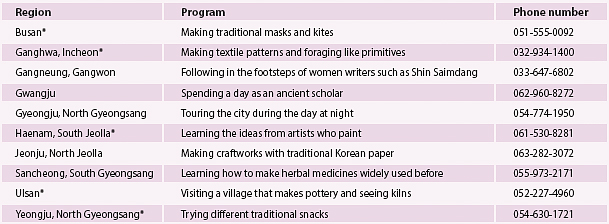New tours highlight old culture

Korea tourism is growing more diverse, such as trying out hanbok, traditional garments, left, in a folk village. Some students visit Wolbong Seowon, middle, a Joseon-era study spot in Gwangju, to learn more about how ancient Koreans studied, and others go to Sancheong to try medicinal herbs used in the Joseon era. [JOONGANG ILBO]
Nighttime tours of palaces sell out within a minute from tickets becoming available online, and more people rent hanbok, traditional Korean garments, and wear them to walk around the historic sites. These things are proof that historic assets have become an essential part in travels across Korea.
Sensing the new trend, the Ministry of Culture, Sports and Tourism has been working to set up more diverse activities to stoke interest in Korean tradition. The ministry has released a list of 10 activities in which many can learn more about how ancient Koreans lived. Visitors can see how Koreans from the prehistoric age lived on the peninsula, or try to paint as if they were an artist in the Joseon Dynasty (1392-1910).
The programs have been selected by both the cultural ministry and the Korea Tourism Organization since last year. Among many available programs, five were chosen last year, and another five this year.
“Such tour programs that include activities and participation from the travelers are not only popular among locals who want to go on some higher-level trips but also among foreign travelers,” said an official with the cultural ministry.
“These programs can help stimulate the tourism industry in other regions beside Seoul and Jeju Island, both of which are known for getting lots of tourists already.”

Sancheong, a town where Joseon-era doctor Heo Jun wrote a medicinal book titled “Dongeuibogam,” has programs including a medicinal spa.
Gyeongju’s program to take visitors to historic sites both during the day and at night is popular. The city ran the program twice a month from March to October last year, and 1,695 people participated, including 255 foreign visitors. The same program is available only once a month this year from 4 to 9 p.m. on the fourth Saturday of each month, and takes tourists to places including Bulguk Temple during the day, and then toward Cheomseongdae, an astronomical observatory built during the Shilla Dynasty (57 B.C. to A.D. 935).
The five programs designated for this year are still in the making, as the cultural ministry and the state-run tourism organization are working to make the program fun for many. A painting class in Haenam may catch the most attention. It takes visitors out to work around the areas artists from the past favored, and to see the landscapes that the artists used to put to paper. This program is an overnight one, and will be available beginning in June. The price for the program is estimated to be 100,000 won ($87.78).
Ulsan’s Ulju County, known for its pottery, will have programs where visitors can make their own. Students will work with a pottery master, and start by firing up a kiln and then making a piece to take home. The program will be available every Saturday from June 10 to Nov. 18. The county is holding a pottery festival until tomorrow.
BY CHOI SEUNG-PYO [summerlee@joongang.co.kr]
원서 클래식 듣고 동의보감 마을서 약초 스파
고리타분하다고 여겼던 우리 전통문화가 ‘체험여행’으로 다시 뜨고 있다. 학생들은 광주 월봉서원에서 선비 체험을 즐긴다. [사진 문화체육관광부]
인증샷 말고는 남는 것 하나 없는 여행에 질린 걸까? 오감으로 느끼는 체험여행이 뜨고 있다. 특히 전에는 구닥다리로 여겨지던 전통문화 체험이 점점 인기를 얻고 있다. 고궁 야경 관람 프로그램이 예약 개시 1분도 안 돼 매진되고, 한복을 입고 고궁이나 문화유산을 둘러보는 사람이 부쩍 늘어난 것만 봐도 알 수 있다.
전통문화 체험은 여기서 머물지 않고 계속 진화하고 있다. 문화체육관광부가 지난 4월 26일 발표한 전통문화 체험 프로그램 10선에는 선사시대 원시인처럼 고인돌을 만들어 보고, 조선시대 미술가의 시각으로 수묵화를 그려 보는 프로그램이 포함돼 있다.
‘전통문화 체험관광 프로그램’은 2016년부터 문체부와 한국관광공사가 지원하는 사업이다. 전국의 수많은 체험 프로그램 중 엄격한 심사를 거쳐 지난해 5개, 2017년인 올해 5개를 선정했다. 여규철 문체부 사무관은 “체험형·참여형 관광은 차별화된 고급 국내 여행을 원하는 내국인뿐 아니라 외국인 여행객 사이에서도 주목받고 있다”며 “관광객이 많은 서울·제주도 이외의 다른 지방 여행 활성화에도 기여할 것”이라고 말했다.
지난해 선정된 프로그램 중 특히 광주광역시 월봉서원 선비문화 체험, 산청 한방테마파크 체험이 높은 호응을 얻고 있다. 광주시 광산구 너브실마을에 있는 월봉서원은 다채로운 프로그램을 운영한다. 서원 입구 ‘다시(茶時) 카페’에서 차를 마시며 클래식을 감상하는 ‘다시 살롱’(매달 첫째·셋째 주 토요일)과 바느질을 배우는 ‘다시 공방’(매달 둘째·넷째 주 토요일)을 진행한다. 조선시대 선비처럼 살아 보는 ‘선비의 하루’ 프로그램은 학생과 외국인에게도 인기다.
『동의보감』의 고장 경남 산청은 한방을 바탕으로 한 힐링여행 명소로 주목받고 있다. 지리산 자락 동의보감촌에서 한방온열 체험, 약초 스파, 뜸 뜨기 등 심신을 치유하는 프로그램이 다채롭다.
천년고도 경주의 낮과 밤을 만끽할 수 있는 ‘야호(夜好) 경주!’ 프로그램도 눈길을 끈다. 2016년 3~10월 매달 두 차례 진행한 프로그램에 1695명(외국인 255명)이 참가했을 정도로 호응을 얻었다. 올해는 매달 한 차례 오후 3시부터 9시까지 진행하는데 낮에는 월성발굴지와 왕경지구 유적지, 불국사 등을 둘러보고 해 진 뒤에는 공연 감상 후 연등을 들고 첨성대 주변을 걷는다. 프로그램을 진행하는 진병길 신라문화원 원장은 “매달 넷째 주 토요일에 진행하는 ‘야호 경주’ 외에도 매주 토요일 오후 7시 서악서원에서 다채로운 무료 공연을 감상할 수 있다”고 귀띔했다.
올해 새롭게 선정된 5개 프로그램은 사실 아직까지 미완성형이다. 문체부와 관광공사에서 계속 내용을 다듬고 있다. 그럼에도 재미난 프로그램이 많다. 해남의 ‘예술가와 함께하는 남도 수묵기행’은 너른 들녘과 올망졸망한 산, 솔숲 등을 옛 화가의 시선으로 감상하고 수묵화를 그려 보는 예술여행이다. 해남 녹우당과 운림산방, 대흥사 등을 둘러본다. 6월부터 1박2일 일정 여행 상품(약 10만원)을 운영할 예정이다. 이달 4일 시작해 7일까지 한시적으로 옹기축제를 여는 울산시 울주군에서는 6월 10일부터 11월 18일까지 토요일마다 체험 프로그램을 운영한다. 옹기 장인과 함께 가마에 불을 지피고 직접 옹기를 만들어 보는 체험을 할 수 있다.
최승표 기자










with the Korea JoongAng Daily
To write comments, please log in to one of the accounts.
Standards Board Policy (0/250자)